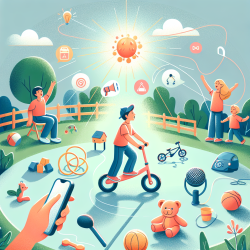Introduction
The COVID-19 pandemic has reshaped many aspects of daily life, particularly for children. With restrictions in place, children's independent mobility (CIM) and physical activity patterns have shifted significantly. This blog post explores the findings from the study "Children’s Independent Mobility and Physical Activity during the COVID-19 Pandemic: A Qualitative Study with Families," offering insights for practitioners on how to enhance their skills and encourage further research in this area.
Key Findings from the Study
The study conducted in British Columbia, Canada, identified three main themes regarding children's mobility and activity during the pandemic:
- Safety Concerns: Families adapted to COVID-19 guidelines, with children learning to play safely while parents collaborated to establish safe play rules.
- Shift in Activity Patterns: There was a noticeable increase in unstructured play, as structured activities were limited. This shift encouraged creativity and independence among children.
- Social Impacts: The pandemic altered social interactions, with children spending more time with family and less with peers, impacting their social development and mental health.
Implications for Practitioners
Practitioners in speech language pathology and related fields can draw several lessons from these findings:
- Promote Unstructured Play: Encourage families to continue fostering unstructured play, which can enhance children's creativity, decision-making, and social skills.
- Support Mental Health: Recognize the social and emotional challenges children face due to reduced peer interaction and provide strategies to support mental well-being.
- Advocate for Safe Play Spaces: Work with communities to ensure access to safe outdoor spaces where children can engage in physical activity while adhering to health guidelines.
Encouraging Further Research
The study highlights the need for ongoing research into the long-term effects of the pandemic on children's mobility and activity patterns. Practitioners are encouraged to explore:
- The impact of unstructured play on language development and social skills.
- Strategies to balance safety concerns with the need for social interaction.
- Innovative approaches to integrate CIM into therapy sessions.
Conclusion
The COVID-19 pandemic has underscored the importance of flexibility and creativity in supporting children's development. By embracing the lessons learned from this period, practitioners can better support children in achieving positive outcomes. For a deeper understanding of the study's findings, you can read the original research paper by following this link: Children’s Independent Mobility and Physical Activity during the COVID-19 Pandemic: A Qualitative Study with Families.










